|
Gilkes-Ross Quadruple Threat
Mike Ross's Switch-Action System in 6BR, .243 AI, 6.5x55, and Rimfire
Other Guns of the Week >
Switch-barrel rifles are not uncommon, but a "switch-action" rifle--now that's real "cutting-edge" gun design. But go to a few 300m and prone matches and you'll see Ross switch-action stocks being used by many of the top competitors. A Ross rifle can be tailored to its owner like a glove, and the switch-action capability makes this one of the most versatile shooting platforms ever invented. Mike himself shoots four calibers through his own Ross rifle: 6BR, .243 Ackley Improved, 6.5x55, and .22 LR.
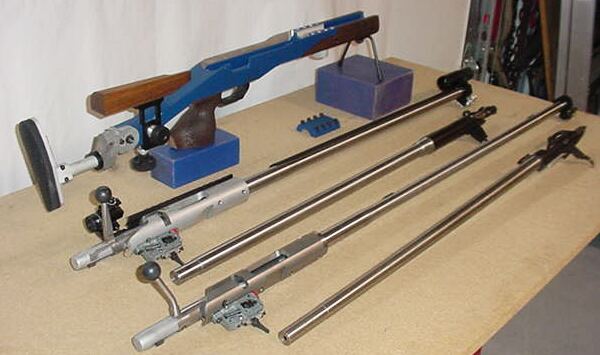
Overview of the Ross Precision Rifle System
We asked Mike Ross about the origins of his high-tech rifle system. He told us: "Some years ago, I got together with Tony Gilkes and we made the decision to provide complete rifles specifically designed for long-range and 300 meter international shooters. Prior to that, Tony had been making custom actions of his own design. These were outstanding, but actions by themselves represented too small a market to be a viable business. The key element missing was a stock, and we decided that aluminum had too much promise and versatility to be ignored.
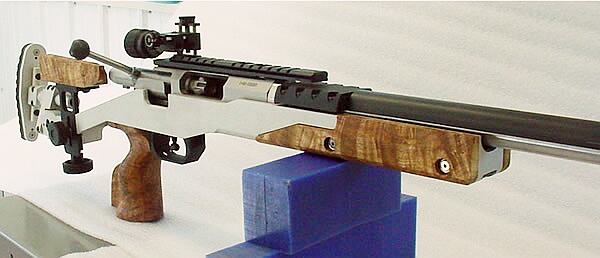
Following the example set by Anschutz and other European suppliers, we chose to improve on their designs by making the stock independent from the type of action and/or barrel the shooter wanted to use. The way to do that was to use the barrel as the mounting mechanism, instead of the action. That way the gun could accommodate a wide variety of precision actions, with various "foot prints" and external profiles. Securing stock to gun via the barrel also eliminated the need for any sort of conventional action bedding (which is always messy, complicated and usually has to be re-done after a season or two of ordinary rifle use).
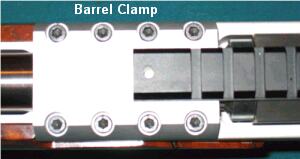 This also solved one of the major problems with rifle accuracy--action flexing. With a conventional system, a small portion of the front of the action supports all the weight of a heavy cantilevered barrel, causing undue flexing of the action/barrel joint, always the weakest link in any rifle. This was not a new idea (Heavy Gun BR shooters had been using barrel blocks for years), but the system had yet to be done for rifles used in prone competition. This also solved one of the major problems with rifle accuracy--action flexing. With a conventional system, a small portion of the front of the action supports all the weight of a heavy cantilevered barrel, causing undue flexing of the action/barrel joint, always the weakest link in any rifle. This was not a new idea (Heavy Gun BR shooters had been using barrel blocks for years), but the system had yet to be done for rifles used in prone competition.
For shooters competing in a variety of disciplines, the barrel-clamp stock design offers many advantages. One stock can accommodate a wide range of different barreled actions, depending on the kind of shooting done on any given day--and the shooter would only have to set the adjustments once. This could range from 6.5-284 for 1000-yard long-range, to 308 Palma, to 6BR for 600-yard shooting, to small-bore for winter gallery leagues, and pretty much anything in between. I have four configurations presently for my own use: 6.5 Swede, .243 Ackley Improved, 6BR, and at least 4 different small-bore barreled actions, any one of which is ready to go in five minutes. All using the same stock.
Mike's Special 6BR Magnesium F-Classer
I have recently switched to shooting F-Class and greatly enjoy 600 yards with the intrepid little 6BR shown below. (You can see some extra components for F-Class--a weight under the fore-end, and a fixture to ride the rear bag.) The inherent accuracy of the 6mm BR cartridge just has to be experienced to be believed. My present package consists of a 30" Krieger 1:7 twist screwed on to a Gilkes action. The trigger is an Anschutz 5022 (the 5018 is also an option for getting under 8 ounces when I'm in the mood for that). The stock however, is not aluminum but rather magnesium. I made a few of them to experiment with the lighter weight, and kept one for myself. In aluminum, the rifle would come in at just under legal Palma weight (14lb 4oz.), but with magnesium it is about 12-14 oz. less. For prone position shooting, there are no less than nine different adjustments to the assembly behind the trigger. These include cheek piece height, offset, and yaw angle. The butt-plate assembly is adjustable for pitch angle, cast-off distance, length-of-pull, height (nearly 6"), cant angle, and shoulder angle. Of course in F-Class, some shooters may not need all of these adjustment options. But for prone shooting, given enough time and futzing with it, you can almost put it on like a glove.
For iron sights I use a Warner in the back, and my own 'Beer Can' front sight. However, the 600-51x I mentioned was done with a rear tube-sight that I made myself, which is a pretty good copy of the old tube-sight Unertl once made for small-bore. For scope, my favorite is the Swarovski 6-24x, but only for F-Class. At about a pound heavier than a Leupold, it's too much weight for prone shooting. But if you don't mind the weight, and can swing the 2K price tag, there is no better scope made. For both optics, and adjustment repeatablilty.
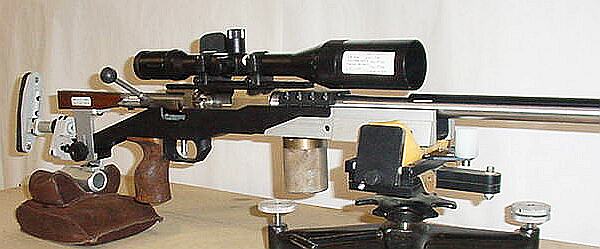
Loads and Shooting Performance--6BR
For the 6BR, I have done a fair amount of experimentation and deciding on a 7-twist barrel has been part of that. I wanted to try the Berger and Tubb 115gr bullets and knew already that 1:8 wasn't viable no matter what case size I tried them in. With the 1:7 however, I have been surprised to find that all the bullets I tried, ranging from 74gr to 107gr, worked relatively well, except for the 115s. They weren't that bad, just all others seemed to be better. The best, hands down, has been the Clinch River 106s, with the Berger 105s and Sierra 107s coming in a close second. The load is your basic no-brainer, 30 grains of Varget. With this configuration, goofing around shooting F-Class with iron sights last year at 600 yards, I surprised myself with 600-51x. But I admit it didn't count for much of anything other than proving to my own satisfaction just how good that cartridge really is.
Just how accurate is the 6BR version of the Ross rifle? First let me say that I have an above-ground 100-yard test tunnel, so that's cheating a little. But using the CR 106s in a bench-rest configuration, it's usually at 0.3" or better. If I use a return-to-battery machine rest, it will drop to 0.2" or under for five rounds. If I really want to show off, I'll drop back to a heavy flat-base bullet and really get some ooh's and aah's. But of course they're a train-wreck at 600 yards in any wind at all.
Loads and Shooting Performance--6.5x55 and .243 Ackley
For both the 6.5 Swede and the 243 AI, I use H4350, 44.5 and 45 grains respectively. But that is just for 1000-yard shooting, which I rarely do any more. For the .243 AI I use the same bullets as for the 6BR, 106gr Clinch Rivers. Interestingly, the .243 AI can pretty much keep up ballistically with a 6.5-284, with nearly 600-lbs less muzzle energy. That makes it a much more comfortable round to shoot. With the 6.5 Swede, I favor Clinch River 147s over the more typical Sierra 142s. At 100 yards you really can't see any difference in groups, but I am subjectively convinced that the CRs do better at 1K.
Adapting Action and Barrel to the Stock--Centerfire and Rimfire
As mentioned previously, the relationship between the stock and various barreled actions is elementary. It all hinges on having the barrel at a 1" diameter for about 4-5 inches forward of the front of the action. With that, the 3" diameter barrel clamp, secured with eight 10:24 screws, can easily handle even the hardest recoil from the bigger cases. When I order barrels from one of the three suppliers I use (Krieger, Border, and Broughton), I simply specify the 'Ross profile' which is 1.250" for about four inches, quickly tapering down to 0.875" over the next three inches, and then that diameter for the remainder of the barrel. This provides all the 'meat' I need for the breech shank (1.1875", 20 thread), with enough left over for the one inch needed for the clamp area.
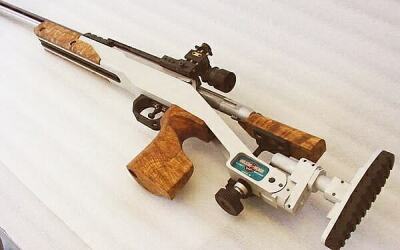 In the case of smallbore, the most common barreled actions that land in my stock are the Anschutz 54 and 20xx series. The barrels on these are always less than one inch (usually 0.925"-0.940"), but shimming this diameter out to the full one inch is no problem at all. I make the shims on request. The stock however, is not universal to all actions. Those that have bolt handles at the back end of the bolt, like the RPA Quadlock and Barnard, will not fit without serious modification to the stock. Still, Remington 700s, Winchester 70s and the like will drop in without problems, provided that the correct barrel diameter is used. The concept of barrel clamping as a solution to heavy barrel issues does seem to be gaining strength. Recently I have been working with a gunsmith in Illinois who makes custom varmint rifles and long-haul benchrest rigs. I supply him with larger (4 inch) mounting blocks designed to drop in to composite BR stocks. Barrel diameters from 1.250" out to 1.500" in the 20-pound range seem to do better in this type of mounting. Also, in the world of small-bore, the issue of extremely sensitive action bolt torque settings just disappears." In the case of smallbore, the most common barreled actions that land in my stock are the Anschutz 54 and 20xx series. The barrels on these are always less than one inch (usually 0.925"-0.940"), but shimming this diameter out to the full one inch is no problem at all. I make the shims on request. The stock however, is not universal to all actions. Those that have bolt handles at the back end of the bolt, like the RPA Quadlock and Barnard, will not fit without serious modification to the stock. Still, Remington 700s, Winchester 70s and the like will drop in without problems, provided that the correct barrel diameter is used. The concept of barrel clamping as a solution to heavy barrel issues does seem to be gaining strength. Recently I have been working with a gunsmith in Illinois who makes custom varmint rifles and long-haul benchrest rigs. I supply him with larger (4 inch) mounting blocks designed to drop in to composite BR stocks. Barrel diameters from 1.250" out to 1.500" in the 20-pound range seem to do better in this type of mounting. Also, in the world of small-bore, the issue of extremely sensitive action bolt torque settings just disappears."
Gilkes-Ross Action -- A Superbly Machined, Innovative Design
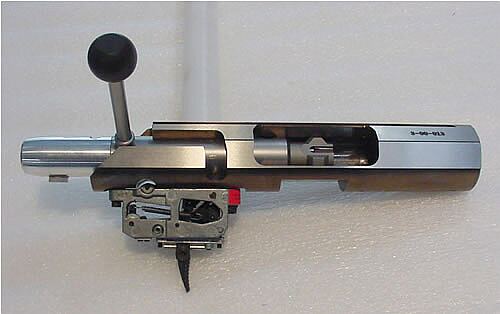
The barrel shank area of the action features a beefy 1 3/16" diameter with a full one-inch length of thread engagement (20 TPI). The breech seats with an internal conical diaphragm providing extremely precise concentricity tolerances. This method also doubles breech strength and eliminates shoulder crush allowances in determining headspace. The overall design is ultra-rigid to maximize accuracy. This also allows absolute repeatability of barrel seating. The action features a long body for enhanced bedding surface when used in a conventional stock installation. A recess is milled in the underside of the action to serve as an integral recoil lug. Unique among U.S.-made custom actions, the Gilkes-Ross is designed to use the advanced Anschutz trigger module.
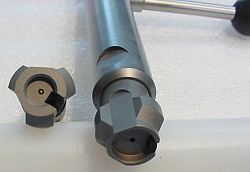 ACTION SPECIFICATIONS ACTION SPECIFICATIONS
Weight ~ 48 ounces
Width ~ 1.5 inches
Height ~ 1.6 inches
Barrel Shank ~ 1.1875" dia., 1.3" length, 20 TPI
Bolt Diameter ~ 0.9375", Right hand (Left optional)
Bolt Faces ~ .223 through standard magnum
Sight Mount ~ Anschütz style dovetail
Locking Lugs ~ (3) conical mating surfaces angled 45°
Loading Port ~ Right hand, 2.8" x 0.95"
Integral Recoil Lug ~ 1.5" long x 1.2" wide x 0.25" deep
Conventional Bedding Bolts ~ (3) 1/4:28 spaced 2.25" inline |
Ross Stock in Review by German Salazar
While Mike has detailed his rifle, I'd like to add a few words about the Ross Precision stock and its use as part of a system. The Ross stock is completely unique in that it will accept just about any barreled action you can think of. Centerfire actions will need to have the barrel shank contoured to a 1.00" straight section for the first 5 inches, smallbore actions, which typically have a straight taper barrel under 1.00", can be accommodated with a pair of machined shims.
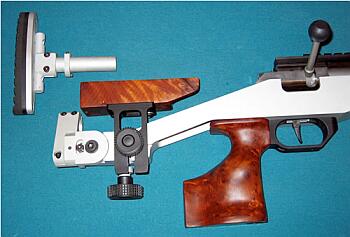 I use my stock with an Anschutz 2013 barreled action in Smallbore matches and can switch to the Ross centerfire action in under 5 minutes. Many competitors in our area do the same. This saves the cost of another stock, and the ability to train and compete with the same stock in two disciplines is a significant benefit. I use my stock with an Anschutz 2013 barreled action in Smallbore matches and can switch to the Ross centerfire action in under 5 minutes. Many competitors in our area do the same. This saves the cost of another stock, and the ability to train and compete with the same stock in two disciplines is a significant benefit.
Apart from the barrel clamping mechanism that allows multi-action use, the most innovative feature of the Ross stock is the butt assembly. No other stock allows as much adjustment in terms of both range of motion and type of motion. Once fitted to your body and position needs, the Ross stock feels like it grew there. If one approaches the adjustments with the idea of seeking the perfect fit and carefully analyzing the contact points, pressure points, sight/eye alignment, eye relief, balance, etc., judicious use of the range of adjustment will serve you well.
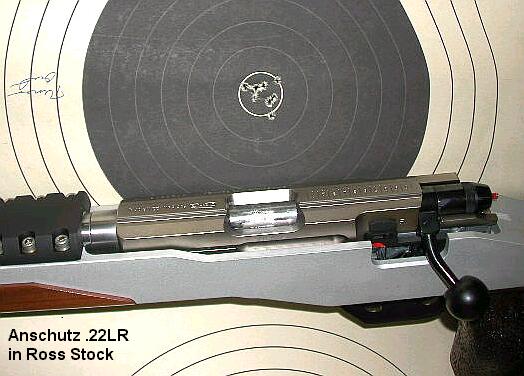
Profile: German Salazar is a noted 300m shooter and a founder of ShootersJournal.com. |
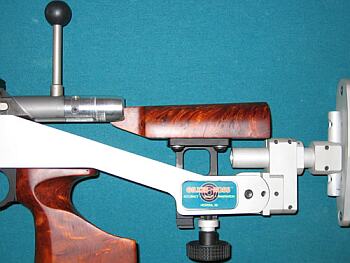 Ross Precision Ross Precision
Mike offered us this profile of his company: "After retiring from the Air Force in 1978, and building a software business which I sold in 1996, I partnered up with Tony Gilkes, the man responsible for one of the best center-fire actions ever. After many years of trying to make a go of it, and about three years with me, he decided it was time to get a job that paid enough to actually live on. He currently resides in Muskegon, Michigan, working for General Dynamics as an armament engineer. Anyway, it's pretty much me and a part-time bookkeeper, and if I have a machine running, the phone might not get answered. What I turn out is actions, barreled actions (for conventional stocks finished elsewhere), complete rifles in my stock, and for the past two years, a 30mm front sight called 'The Beer Can', which I designed to help out the older prone shooters. I just finished the design of a version of that for small-bore. In between long days at the shop, I try to get in a little shooting but it's a lot less than it used to be. Another project I have just completed has to do with F-Class shooting, consisting of 'add-ons' for the basic aluminum stock so that it can ride the bags correctly.
I don't actually make the Gilkes action from scratch, that's done in a machine shop in the deep south by the best machinist I have ever known, who also wishes to remain anonymous. But I do make everything else relating to the stocks, along with barrel-fitting work. I am very proud of the design of the stock, and pleased at the acceptance it has slowly but steadily earned. By most standards it is no work of art, compared to a nice piece of fiddleback walnut, but it is a real workhorse that can withstand a lifetime of abuse in nearly any kind of shooting you care to do. It's anodized, so when you get to where you can't stand the sight of it anymore, you can always buff out the scratches, and re-anodize it in a different color."

Ross Precision Manufacturing, Inc.
1522 West 40th Street
Fremont, MI 49412
Phone: 231.924.5755 | Fax: 231.924.5442 |
You Can Help Support 6mmBR.com by Making a Small, Secure Donation.
Stock and rifle images Copyright © 2005, Ross Precision, used by permission, All Rights Reserved.
Target image Copyright © 2005, German Salazar, used by permission, All Rights Reserved. All other content Copyright © 2005, 6mmBR.com, All Rights Reserved. No reproduction of any content without advanced permission in writing.
Topics: 6mm, 6mm BR, 6BR, Norma, 243 Ackley Improved, .243 Ackley, .243 AI, 6.5x55, 6.5 Swede, Rimfire, .22 LR, 22LR, Anschutz, Ross, Ross Precision, Gilkes, Gilkes-Ross, Switch Barrel, 6PPC, 6.5-284, 1000 yards, 300m, 300 meter, F-Class, Benchrest, BR, Bench Rest, Single-shot, competition, rifle accuracy, Norma, Hodgdon Powder, H4350, Varget, Vihtavuori, Berger Bullets, Sierra, Clinch River, Lapua Scenar, Sierra, MatchKing, Competition Shooting, stocks, Border Barrel, Broughton, Krieger, stainless barrel, Tubb 2000, reloading, powder, case forming, neck-turning, Lapua Brass, Scenar, bullets, precision.


|